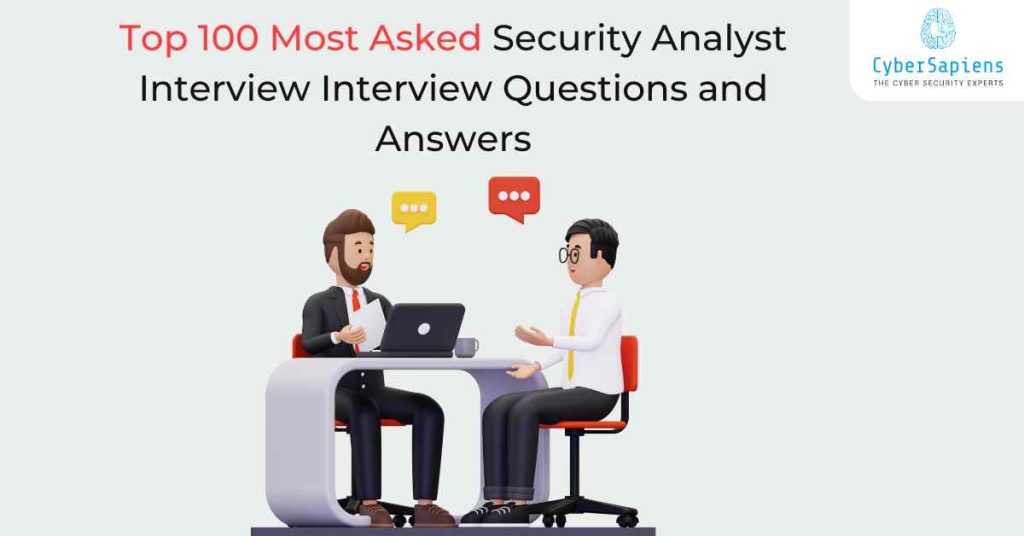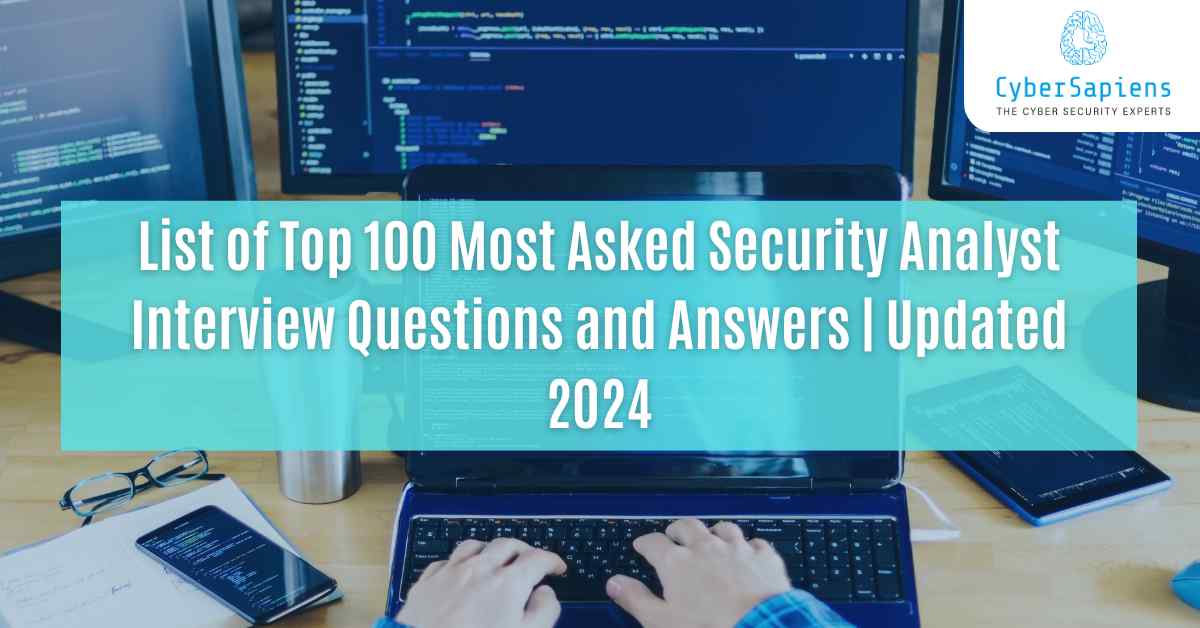As a security analyst, you play a crucial role in protecting an organization’s computer systems, networks, and infrastructure from cyber threats.
To land a job in this field, you need to be well-prepared to answer a range of questions that will test your skills, knowledge, and experience. In this article, we have compiled the top 100 most asked security analyst interview questions and answers to help you prepare for your next interview.
List of Top 100 Most Asked Security Analyst Interview Questions and Answers | Updated 2024

Here is the list of Top 100 Most Asked Security Analyst Interview Questions and Answers:
1. What is the role of a security analyst in an organization?
A security analyst is responsible for designing, implementing, and maintaining an organization’s security infrastructure to protect its digital assets from threats and vulnerabilities.
2. What are the three primary goals of security?
The three primary goals of security are confidentiality, integrity, and availability (CIA).
3. What is the difference between a threat, vulnerability, and risk?
A threat is a potential attack on an organization’s assets, a vulnerability is a weakness in a system that can be exploited, and a risk is the likelihood and potential impact of a threat exploiting a vulnerability.
4. What is a security incident response plan?
A security incident response plan is a set of procedures that outline how an organization will respond to a security incident, such as a data breach or ransomware attack.
5. What is the difference between a security policy and a security procedure?
A security policy is a high-level document that outlines an organization’s security objectives and requirements, while a security procedure is a detailed step-by-step guide on how to implement a specific security policy.

6. What is NIST?
NIST (National Institute of Standards and Technology) is a non-regulatory agency of the US government that provides guidelines, standards, and best practices for information security.
7. What is the NIST Cybersecurity Framework?
The NIST Cybersecurity Framework is a voluntary framework that provides guidelines and best practices for managing and reducing cybersecurity risk.
8. What is a vulnerability scan?
A vulnerability scan is an automated process that identifies potential vulnerabilities in a system or network.
9. What is penetration testing?
Penetration testing is a simulated cyber attack on a system or network to test its defences and identify potential vulnerabilities.
10. What is the difference between a black box, grey box, and white box test?
A black box test is a penetration test where the tester does not know the system or network, a grey box test is a penetration test where the tester has partial knowledge of the system or network, and a white box test is a penetration test where the tester has full knowledge of the system or network.
11. What is a firewall?
A firewall is a network security system that monitors and controls incoming and outgoing network traffic based on predetermined security rules.
12. What is a DMZ?
A DMZ (Demilitarized Zone) is a network segment that separates the Internet from an internal network, providing an additional layer of security.
13. What is a VPN?
A VPN (Virtual Private Network) is a technology that allows users to securely connect to a network over the Internet.
14. What is encryption?
Encryption is the process of converting plaintext data into unreadable ciphertext data to protect it from unauthorized access.
15. What is decryption?
Decryption is the process of converting ciphertext data back into plaintext data.
16. What is a public key infrastructure (PKI)?
A PKI is a system that enables the creation, management, and distribution of public-private key pairs for secure communication.
17. What is a certificate authority (CA)?
A CA is an entity that issues digital certificates to verify the identity of individuals, organizations, or devices.
18. What is a digital signature?
A digital signature is a cryptographic mechanism that verifies the authenticity and integrity of a message or document.
19. What is a hash function?
A hash function is a mathematical function that takes input data of any size and produces a fixed-size string of characters, known as a message digest.
20. What is SSL/TLS?
SSL/TLS (Secure Sockets Layer/Transport Layer Security) is a cryptographic protocol that provides secure communication between a client and a server.
21. What is HTTPS?
HTTPS (Hypertext Transfer Protocol Secure) is a secure communication protocol that combines HTTP with SSL/TLS to provide secure communication between a client and a server.
22. What is a security information and event management (SIEM) system?
A SIEM system is a solution that collects, monitors, and analyzes log data from various sources to provide real-time insights into security threats.
23. What is threat intelligence?
Threat intelligence is the process of gathering, analyzing, and sharing information about potential security threats to improve incident response and threat prevention.
24. What is a security operations centre (SOC)?
A SOC is a centralized unit that monitors and responds to security incidents in real time.
25. What is incident response?
Incident response is a systematic approach to identifying, containing, and mitigating the impact of a security incident.
26. What is a disaster recovery plan?
A disaster recovery plan is a set of procedures that outline how an organization will recover from a disaster or major outage.
27. What is a business continuity plan?
A business continuity plan is a set of procedures that outline how an organization will continue to operate during a disaster or major outage.
28. What is a risk assessment?
A risk assessment is a systematic process of identifying, evaluating, and prioritizing potential security risks.
29. What is a vulnerability assessment?
A vulnerability assessment is a systematic process of identifying and evaluating potential vulnerabilities in a system or network.
30. What is a compliance audit?
A compliance audit is an independent examination and evaluation of an organization’s security controls to ensure they meet regulatory or industry standards.
31. What is HIPAA?
HIPAA (Health Insurance Portability and Accountability Act) is a US law that governs the protection of sensitive health information.
32. What is PCI-DSS?
PCI-DSS (Payment Card Industry Data Security Standard) is a set of security standards for organizations that handle credit card information.
33. What is GDPR?
GDPR (General Data Protection Regulation) is a European Union law that governs the protection of personal data.
34. What is a security awareness program?
A security awareness program is a systematic approach to educating employees about security best practices and risks.
35. What is phishing?
Phishing is a social engineering attack that uses email or messaging to trick individuals into revealing sensitive information.
36. What is social engineering?
Social engineering is a type of attack that uses psychological manipulation to trick individuals into revealing sensitive information.
37. What is a zero-day exploit?
A zero-day exploit is a previously unknown vulnerability that is exploited by an attacker before a patch or fix is available.
38. What is a buffer overflow?
A buffer overflow is a type of vulnerability that occurs when more data is written to a buffer than it can hold, allowing an attacker to execute malicious code.
39. What is SQL injection?
SQL injection is a type of vulnerability that occurs when an attacker injects malicious SQL code to extract or modify sensitive data.
40. What is cross-site scripting (XSS)?
XSS is a type of vulnerability that occurs when an attacker injects malicious code into a website to steal user data or take control of the user’s session.
41. What is a denial of service (DoS) attack?
A DoS attack is a type of attack that attempts to make a system or network unavailable by flooding it with traffic.
42. What is a distributed denial of service (DDoS) attack?
A DDoS attack is a type of attack that uses multiple compromised systems to flood a system or network with traffic.
43. What is a man-in-the-middle (MITM) attack?
A MitM attack is a type of attack that occurs when an attacker intercepts communication between two parties to steal or modify data.
44. What is a Trojan horse?
A Trojan horse is a type of malware that disguises itself as legitimate software to gain unauthorized access to a system.
45. What is ransomware?
Ransomware is a type of malware that encrypts files and demands payment in exchange for the decryption key.
46. What is a botnet?
A botnet is a network of compromised systems that can be controlled remotely to conduct DDoS attacks, send spam, or steal sensitive information.
47. What is a worm?
A worm is a type of malware that replicates itself to spread to other systems without the need for human interaction.
48. What is a virus?
A virus is a type of malware that attaches itself to a program or file to replicate itself and spread to other systems.
49. What is a rootkit?
A rootkit is a type of malware that hides itself and other malicious programs from the operating system and security software.
50. What is a logic bomb?
A logic bomb is a type of malware that is designed to execute malicious code when a specific condition is met.
51. What is a spyware?
Spyware is a type of malware that monitors user activity and steals sensitive information without their knowledge or consent.
52. What is adware?
Adware is a type of malware that displays unwanted advertisements on a system.
53. What is a keylogger?
A keylogger is a type of malware that records user keystrokes to steal sensitive information such as passwords and credit card numbers.
54. What is a backdoor?
A backdoor is a type of malware that provides unauthorized access to a system or network.
55. What is a digital certificate?
A digital certificate is an electronic document that verifies the identity of an individual, organization, or device.
56. What is a public key?
A public key is a cryptographic key that is used to encrypt data that can only be decrypted with a corresponding private key.
57. What is a private key?
A private key is a cryptographic key that is used to decrypt data that was encrypted with a corresponding public key.
58. What is a hybrid cloud?
A hybrid cloud is a cloud computing environment that combines on-premises infrastructure with public cloud services.
59. What is a cloud security gateway?
A cloud security gateway is a security solution that monitors and controls traffic between a cloud service and the Internet.
60. What is a cloud access security broker (CASB)?
A CASB is a security solution that monitors and controls cloud service usage to detect and prevent security threats.
61. What is a security orchestration, automation, and response (SOAR) solution?
A SOAR solution is a security solution that automates and streamlines incident response processes to improve efficiency and effectiveness.
62. What is a managed security service provider (MSSP)?
An MSSP is a third-party provider that offers security services, such as monitoring and incident response, to customers.
63. What is a security incident response team (SIRT)?
A SIRT is a team of security professionals that responds to security incidents to contain and mitigate the impact of the incident.
64. What is a security operations centre (SOC) as a service?
A SOC as a service is a managed security service that provides 24/7 security monitoring and incident response to customers.
65. What is compliance as a service?
Compliance as a service is a managed service that helps organizations comply with regulatory requirements and industry standards.
66. What is penetration testing as a service?
Penetration testing as a service is a managed service that provides recurring penetration testing to identify vulnerabilities and improve security posture.
67. What is vulnerability management as a service?
Vulnerability management as a service is a managed service that identifies and prioritizes vulnerabilities, provides remediation guidance, and tracks progress.
68. What is threat intelligence as a service?
Threat intelligence as a service is a managed service that provides real-time threat intelligence feeds to help organizations improve their incident response and threat prevention capabilities.
69. What is a security awareness training as a service?
Security awareness training as a service is a managed service that provides regular security awareness training to employees to improve their security knowledge and behaviours.
70. What is a cloud workload protection platform (CWPP)?
A CWPP is a security solution that protects cloud-native applications and workloads.
71. What is a cloud security posture management (CSPM)?
A CSPM is a security solution that provides visibility and control over cloud security posture to identify and remediate security risks.
72. What is a cloud access security broker (CASB)?
A CASB is a security solution that monitors and controls cloud service usage to detect and prevent security threats.
73. What is cloud infrastructure entitlement management (CIEM)?
A CIEM is a security solution that provides visibility and control over cloud infrastructure entitlements to prevent privilege escalation and reduce the attack surface.
74. What is cloud-based security information and event management (SIEM)?
A cloud-based SIEM is a security solution that collects, monitors, and analyzes log data from cloud and on-premises sources to provide real-time insights into security threats.
75. What is a cloud-based security orchestration, automation, and response (SOAR)?
A cloud-based SOAR is a security solution that automates and streamlines incident response processes to improve efficiency and effectiveness.
76. What is a cloud-based managed security service provider (MSSP)?
A cloud-based MSSP is a third-party provider that offers cloud-based security services, such as monitoring and incident response, to customers.
77. What is a cloud-based security incident response team (SIRT)?
A cloud-based SIRT is a team of security professionals that responds to security incidents in cloud environments to contain and mitigate the impact of the incident.
78. What is a cloud-based security operations centre (SOC)?
A cloud-based SOC is a centralized unit that monitors and responds to security incidents in cloud environments in real time.
79. What is cloud-based cloud security monitoring?
Cloud-based cloud security monitoring is a solution that provides real-time visibility into cloud security threats and risks
80. What is a cloud-based vulnerability management system?
A cloud-based vulnerability management system is a solution that identifies, classifies, and prioritizes vulnerabilities in cloud-based systems and applications.
81. What is a cloud-based threat intelligence platform?
A cloud-based threat intelligence platform is a solution that provides real-time threat intelligence feeds to help organizations improve their incident response and threat prevention capabilities.
82. What is a cloud-based security awareness training program?
A cloud-based security awareness training program is a solution that provides regular security awareness training to employees to improve their security knowledge and behaviours.
83. What is a cloud-based incident response playbook?
A cloud-based incident response playbook is a pre-defined set of procedures and guidelines for responding to security incidents in cloud environments.
84. What are cloud-based security metrics and reporting?
Cloud-based security metrics and reporting is a solution that provides real-time visibility into cloud security posture, risk, and compliance.
85. What is cloud-based compliance and risk management?
Cloud-based compliance and risk management is a solution that helps organizations manage risk and comply with regulatory requirements in cloud environments.
86. What is a cloud-based identity and access management (IAM)?
Cloud-based IAM is a solution that manages identities, access, and privileges in cloud environments to prevent unauthorized access and data breaches.
87. What is a cloud-based single sign-on (SSO)?
Cloud-based SSO is a solution that allows users to access multiple cloud-based applications and services with a single set of login credentials.
88. What is a cloud-based multi-factor authentication (MFA)?
Cloud-based MFA is a solution that adds a layer of security to the authentication process by requiring users to provide additional verification factors.
89. What is a cloud-based encryption?
Cloud-based encryption is a solution that protects data in transit and at rest in cloud environments using advanced encryption algorithms.
90. What is cloud-based key management?
Cloud-based key management is a solution that securely manages encryption keys in cloud environments to prevent unauthorized access to encrypted data.
91. What is a cloud-based data loss prevention (DLP)?
Cloud-based DLP is a solution that monitors and controls data in cloud environments to prevent unauthorized data exfiltration and data breaches.
92. What is a cloud-based cloud access security broker (CASB)?
Cloud-based CASB is a solution that monitors and controls cloud service usage to detect and prevent security threats.
93. What is a cloud-based cloud workload protection platform (CWPP)?
Cloud-based CWPP is a solution that protects cloud-native applications and workloads.
94. What is a cloud-based cloud security posture management (CSPM)?
Cloud-based CSPM is a solution that provides visibility and control over cloud security posture to identify and remediate security risks.
95. What is a cloud-based cloud infrastructure entitlement management (CIEM)?
Cloud-based CIEM is a solution that provides visibility and control over cloud infrastructure entitlements to prevent privilege escalation and reduce the attack surface.
96. What is a cloud-based cloud security governance?
Cloud-based cloud security governance is a solution that provides a framework for managing cloud security risks and compliance across an organization.
97. What is cloud-based cloud risk management?
Cloud-based cloud risk management is a solution that identifies, assesses, and prioritizes cloud security risks to inform business decisions.
98. What is cloud-based cloud compliance management?
Cloud-based cloud compliance management is a solution that helps organizations manage compliance with regulatory requirements in cloud environments.
99. What is cloud-based cloud audit management?
Cloud-based cloud audit management is a solution that provides a framework for managing cloud security audits and assessments.
100. What is cloud-based cloud security analytics?
Cloud-based cloud security analytics is a solution that provides real-time insights into cloud security threats and risks using advanced analytics and machine learning.
Conclusion
With the help of these top 100 security analyst interview questions and answers, you will be ready to face any interview and prove that you are the most suitable candidate for the position of security analyst, risk manager, or threat prevention. Rehearse your answers and make sure you can describe instances from your previous experiences. Good luck
FAQs: Top 100 Most Asked Security Analyst Interview Questions and Answers
1. How can I boost my confidence before a job interview?
Ans: To boost your confidence before a job interview, prepare thoroughly by researching the company and the role, practising your responses to common interview questions, and visualizing yourself attending the interview. Also, remind yourself of your strengths and accomplishments, and focus on the skills and experiences that make you a great fit for the job. Finally, take care of yourself physically and mentally by getting enough sleep, eating well, and exercising to reduce stress and anxiety.
2. What if I’m feeling anxious or nervous about the interview?
Ans: It’s normal to feel some level of anxiety or nervousness before an interview. However, instead of letting it overwhelm you, try to reframe your thinking by focusing on the opportunities that this interview presents. Remind yourself that this is a chance to learn more about the company and the role, and to showcase your skills and experiences. Take deep breaths, and try to relax by doing some light stretching or meditation before the interview.
3. How can I overcome imposter syndrome before a job interview?
Ans: Imposter syndrome is a common phenomenon where people doubt their abilities and feel like they’re not qualified enough for a role. To overcome it, focus on your strengths and accomplishments, and remind yourself of how you’ve successfully tackled similar challenges in the past. Also, reframe your thinking by focusing on what you can bring to the role, rather than what you don’t know. Finally, remember that it’s okay to not have all the answers – it’s normal to learn and grow on the job.
4. What if I’m worried about not getting the job?
Ans: It’s natural to worry about not getting the job, but try not to let it consume you. Instead, focus on what you can control, such as preparing for the interview, being yourself, and showcasing your skills and experiences. Remind yourself that it’s okay to not get every job you apply for and that it’s all part of the learning and growing process. Also, try to focus on the things that you want to achieve in the role, rather than just getting the job itself.
5. How can I maintain a positive attitude before a job interview?
Ans: To maintain a positive attitude before a job interview, focus on the opportunities that this interview presents, rather than the obstacles or challenges. Remind yourself of your strengths and accomplishments, and try to visualize yourself succeeding in the role. Also, try to focus on the things that you’re grateful for, such as the opportunity to interview for the job, and the skills and experiences that you bring to the table. Finally, try to reframe any negative thoughts or self-doubt by focusing on the positive aspects of the situation.












